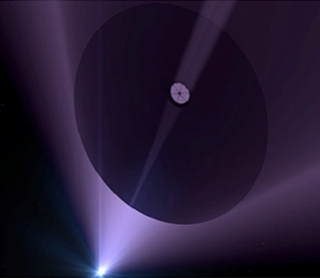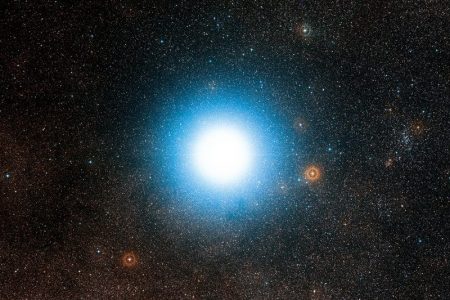December 29, 2017 – Maybe this driving interest in the search for extraterrestrial intelligence is fuelled by the lack of intelligent leadership south of the Canadian border. Or maybe it’s because of the U.S. Department of Defense, and its recent admission to keeping tabs on unidentified flying objects, that compells me to dig into this subject further.
For whatever reason, the topic is on my mind, and let me tell you why.
A Jet Propulsion Laboratory scientist, Anthony Freeman, presented a concept at the 2017 American Geophysical Union conference, held in New Orleans, Louisiana, on December 12th, for a 2069 interstellar mission, to take us to Proxima Centauri, our nearest neighbour. The goal would be to visit the star and its planets in search of Earth-like environments and alien intelligence. Freeman said that he and others working with NASA had been tossing around this idea for some time.
In his presentation he noted the technological impediments to such a mission:
- The need to develop propulsion systems capable of near-light speed.
- The need to develop deceleration capability allowing us to enter into orbit around a targeted star multiple light-years away without any human intervention.
- The need to ensure sustainability over a century in space ensuring the viability of the instrumentation to be used upon arrival at the star system.
- The need for communications technology able to receive data from our probe throughout its multi-light-year journey, and from it upon arrival and as it explores the worlds it encounters.
For the first challenge, a propulsion technology sufficiently fast to get us to Proxima Centauri within a century requires the development of new engines which could take the form of:
- Directed-photonic energy which would use a guided laser fired at our spacecraft to push it over several decades to achieve reasonable sub-light speed.
- A nuclear-fission engine that would set off controlled atomic bomb detonations behind the spacecraft to accelerate it in increments.
- An antimatter-matter engine which would create similar to the above-controlled detonations to accelerate the spacecraft.

What would be a reasonable attainable speed?
About 10% the speed of light or just under 108 million kilometers per hour.
To date, the fastest speeds attained by a spacecraft is 265,000 kilometers (165,000 miles) per hour. This speed has been attained by the Juno probe in its journey to and around Jupiter. At less than 0.25% of the speed we are describing for our proposed interstellar trip, that’s a far cry to go from where we are to where we want to be.
But let’s say we solve the propulsion issue and now have a propulsion system able to hit 10% sub-light speed. Now we have to consider spacecraft design. We have to give it longevity to operate over a distance and time equal to an Earth century. We will need to ensure its instrumentation will remain pristine throughout the long voyage through the near vacuum and cold of interstellar space.
And we have to make our spacecraft intelligent, if not conscious. Today artificial intelligence is not yet conscious. But it will be an important capacity of our interstellar spacecraft which will need to be wakeful as it navigates through the time and distance of interstellar space. It will have to make independent decisions should it encounter something unanticipated.
And then there is deceleration, a technology that will have to be on board the spacecraft. Could it fire a laser at an object it detects within the Proxima Centauri system that could then act as a decelerator? It won’t know about such an object until it probes the system well ahead of time, possibly several decades before arrival. And then it will have to calculate the movement of that object to fire the laser and receive the reflection back to continually decelerate. That’s not a job for a dummy. There will be no human or computer system to reference to ensure the mathematics is right.
Assuming the deceleration decision is right it could be a decade or more before the spacecraft arrives and inserts itself into orbit around the star. Then it has to make many other decisions: what to study among the objects it encounters. It needs to determine which of those objects has conditions for potential habitability. Then it needs to search for bio-signs. And finally, if bio-signs are present, it needs to search for evidence of alien intelligence including the presence of technology.
It is spacecraft with these capabilities and not starships like the fictional U.S.S. Enterprise of Star Trek that will be our interstellar explorers of the future. And as explorers and ambassadors, they will represent us in space. And if they make contact with an intelligent, technical species, it is my guess that they will most likely meet alien artificial intelligence surrogates similar to them, and not biological beings.
Why is that and why not Star Trek?
Because our Universe has a speed limit that cannot be exceeded, the speed of light. The physical limits of the speed of light at a sub-atomic level require vast amounts of energy. And subatomic particles when accelerated to near-light speed become heavier requiring increasing amounts of energy to keep them moving at a constant speed let alone an accelerating pace. So unless we find rifts in space, the wormholes of many science fiction novels, where we can bend space and time to jump across vast interstellar distances, we remain stuck at a speed that accommodates our spacecraft’s ability to travel at sub-light speeds while not accelerating to a point where its increasing heaviness impedes its progress.
A voyage to Proxima Centauri, our nearest neighbour is a century-long mission. Voyages to other stars will take far longer. There are a lot of targets as we are finding out in these last few decades. Based on the current Kepler Space Telescope‘s dataset, and from exoplanet observations from Earth-based telescopes, astronomers conclude that between 70 and 80% of the stars in our Milky Way Galaxy host one or more planets. And based on the thousands of exoplanets already known to us, the ratio of rocky to gas giants is turning out to be 1:5. Not all rocky planets have the ability to support water in all its forms on the surface. But the estimated number of such planets just in our galaxy is upwards of 100 billion. That’s a lot of territory to cover for future interstellar missions.
And in this posting, I ask a final question. When not if we encounter biological or artificial intelligence on one of these voyages of discovery, should our artificial ambassadors of humanity seek contact? Is there anything to fear if this should happen considering the enormous distances of interstellar space that will always separate us despite what science fiction writers state as possible.








